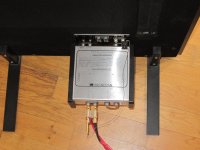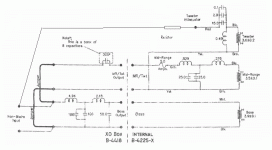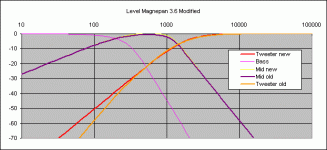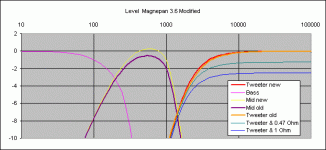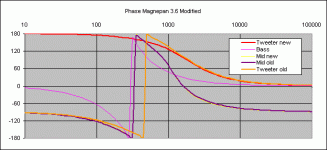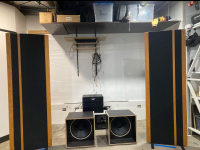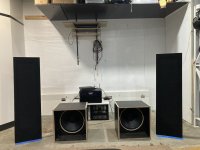I'd like to share my experience with this. So far, I have converted one pair of Magnepan 3.7, two pairs of 3.6 and one pair of 1.6 to active crossovers. Well, I also did a pair of 1.5, but that was later reverted to the original passive crossover.
The first question may be - why do it? First of all - because you can, and it fun and easy to do. You can also make it a much better speaker in my opinion.
The first task will be to open the speaker and bypass the internal crossover. All Magnepans made the last 30 years or so have an internal crossover located below the speaker panels, facing the front side of the speaker. Some, like the 3.6/R, also have an external in addition. I guess they did it like that because they couldn't fit the whole thing inside the speaker. The later 3.7 have a rather odd series crossover, which requires less parts. The entire 3.7 crossover resides inside the speaker. All 1.x, 0.x models, the LRS, 20.7 and a few others have internal crossovers only.
There are basically two ways of accessing the crossover:
1) Take off the "sock" or cloth cover
2) Cut a hole in the cloth
The latter can be done with 3.6 and 3.7, as the front cover can be taken off, and the hole in the "sock" will not be visible. On any 1.x model, you need to take off the "socks". The next post will cover how to open a 3.6/3.7.
The first question may be - why do it? First of all - because you can, and it fun and easy to do. You can also make it a much better speaker in my opinion.
The first task will be to open the speaker and bypass the internal crossover. All Magnepans made the last 30 years or so have an internal crossover located below the speaker panels, facing the front side of the speaker. Some, like the 3.6/R, also have an external in addition. I guess they did it like that because they couldn't fit the whole thing inside the speaker. The later 3.7 have a rather odd series crossover, which requires less parts. The entire 3.7 crossover resides inside the speaker. All 1.x, 0.x models, the LRS, 20.7 and a few others have internal crossovers only.
There are basically two ways of accessing the crossover:
1) Take off the "sock" or cloth cover
2) Cut a hole in the cloth
The latter can be done with 3.6 and 3.7, as the front cover can be taken off, and the hole in the "sock" will not be visible. On any 1.x model, you need to take off the "socks". The next post will cover how to open a 3.6/3.7.
How to open up a 3.6/3.7
No matter what you do when it comes to moving a 3.6/3.7 around - be sure to attach the tweeter protection straps! These are long metal straps, that shall be attached to the rear side of the tweeters. It is especially important to do this during this procedure.
I'd recommend having two large tables available to do this work.

1. Place the speaker on a large table with the front of the speaker facing down. Put a tablecloth on the table first to avoid scratches
2. Remove the speaker feet
3. On 3.6, remove the external crossover
4. Remove all jumpers and attenuators from the speaker terminals. Leave the fuses.
5. Remove all screws holding the front cover. They are around the edge of the speaker, as well as a few between the ribbon and mid/bass panel.
6. Gently lift the speaker off the front cover and place it on the other table. Leave the front cover in place. This makes it easier to reattach it.
Now, you must decide of you want to cut a hole in the sock or try to take it off. The first method is by far the easiest.
Method #1 - cut a hole in the sock
Place the speaker with the front facing up. Locate the crossover behind the cloth, and just cut it open with a pair of scissors.

Method #2 - remove the sock
Place the speaker on the table with the front down. Start by removing some hundred-ish staples at the bottom of the speaker. If there are small feet under the speaker (the white one in the picture above), remove those as well. Remove the four screws holding the speaker terminal plate. Then gently roll up the clotch to uncover the crossover. After you're done, the cloth should be stapled on again.

No matter what you do when it comes to moving a 3.6/3.7 around - be sure to attach the tweeter protection straps! These are long metal straps, that shall be attached to the rear side of the tweeters. It is especially important to do this during this procedure.
I'd recommend having two large tables available to do this work.
1. Place the speaker on a large table with the front of the speaker facing down. Put a tablecloth on the table first to avoid scratches
2. Remove the speaker feet
3. On 3.6, remove the external crossover
4. Remove all jumpers and attenuators from the speaker terminals. Leave the fuses.
5. Remove all screws holding the front cover. They are around the edge of the speaker, as well as a few between the ribbon and mid/bass panel.
6. Gently lift the speaker off the front cover and place it on the other table. Leave the front cover in place. This makes it easier to reattach it.
Now, you must decide of you want to cut a hole in the sock or try to take it off. The first method is by far the easiest.
Method #1 - cut a hole in the sock
Place the speaker with the front facing up. Locate the crossover behind the cloth, and just cut it open with a pair of scissors.
Method #2 - remove the sock
Place the speaker on the table with the front down. Start by removing some hundred-ish staples at the bottom of the speaker. If there are small feet under the speaker (the white one in the picture above), remove those as well. Remove the four screws holding the speaker terminal plate. Then gently roll up the clotch to uncover the crossover. After you're done, the cloth should be stapled on again.
The next challenge is to rewire the speaker and bypass the passive crossover.
We also need to think about connections. I decided to use the original terminal plate, as well as keep the original fuses for protection. It has saved me from at least one burnt tweeter.
On the three-way models, we need three pairs of speaker terminals, and two for the two-way models. With the 1.5 and 1.6 this is easy, as the speaker already is capable of bi-wiring, and actually has three sets of terminals. The three-way 1.7, sadly, only have two pairs of terminals. Both 3.6 and 3.7 has got three pairs.
This is how I did it on a pair of 3.6. The bass terminal is used for the bass panel of course, the MR/TW terminal is used for the midrange, and the Tweeter Attenuator terminal is used for the tweeter. You can do it much the same way with the 3.7 using the MR and TW attenuator terminals, and the main input terminal for the bass.

When the connections are worked out, we bypass the passive filter and wire the panels directly to the terminals.
DO NOT EVER think of soldering wire directly to the panel connections. The best solution is to keep the original wires going from the panels. Cut all of them away from the crossover plate, and route them to the terminals. Some wires may be too short and needs to be spliced.
As I said before, I recommend keeping the tweeter and midrange fuses for safety reasons.
This is the modified wiring of the 3.6

The 3.7 is using the same wire colors as the 3.6, except for the tweeter that's using green (+) and yellow (-) wires.

How to keep the fuses (3.7 shown here)

Wire colors on the 1.6 and 1.5 is the same as for 3.6 / 3.7 woofer/midrange.
We also need to think about connections. I decided to use the original terminal plate, as well as keep the original fuses for protection. It has saved me from at least one burnt tweeter.
On the three-way models, we need three pairs of speaker terminals, and two for the two-way models. With the 1.5 and 1.6 this is easy, as the speaker already is capable of bi-wiring, and actually has three sets of terminals. The three-way 1.7, sadly, only have two pairs of terminals. Both 3.6 and 3.7 has got three pairs.
This is how I did it on a pair of 3.6. The bass terminal is used for the bass panel of course, the MR/TW terminal is used for the midrange, and the Tweeter Attenuator terminal is used for the tweeter. You can do it much the same way with the 3.7 using the MR and TW attenuator terminals, and the main input terminal for the bass.
When the connections are worked out, we bypass the passive filter and wire the panels directly to the terminals.
DO NOT EVER think of soldering wire directly to the panel connections. The best solution is to keep the original wires going from the panels. Cut all of them away from the crossover plate, and route them to the terminals. Some wires may be too short and needs to be spliced.
As I said before, I recommend keeping the tweeter and midrange fuses for safety reasons.
This is the modified wiring of the 3.6
The 3.7 is using the same wire colors as the 3.6, except for the tweeter that's using green (+) and yellow (-) wires.
How to keep the fuses (3.7 shown here)
Wire colors on the 1.6 and 1.5 is the same as for 3.6 / 3.7 woofer/midrange.
After the rewiring is complete, it's time to put the speaker back together again. But wait.... please check that all connections are good before you do so. You can measure with a multimeter across each terminal. You should see 3-4 ohms resistance between + and - in each terminal pair. Also check that there are no short circuits between any combination of the terminals.
Staple the cloth using ~100 staples..... or just put the fronts back on again. Mount the terminal plate, and the feet.
You have now succeeded in creating a speaker you cannot use. Yet.
Staple the cloth using ~100 staples..... or just put the fronts back on again. Mount the terminal plate, and the feet.
You have now succeeded in creating a speaker you cannot use. Yet.
I decided to use Hypex FusionAmp plate amps for my Magnepans, as they are up to three-way with integrated power amps. This proved to be a poor choice, because the FusionAmp's 100W tweeter amp simply isn't powerful enough for the Magnepan ribbon tweeter. It goes into protection even at moderate SPL. I ended up with using the three-way FusionAmps on my Magnepan 3.6 surround speakers, and the front L-R (Magnepan 3.7) and center (Magnepan 3.6) speakers got two separate FusionAmps each - FA502 on the bass/mid and a brigded FA252 on the tweeter.
Your choice may be different... Personally, I would probably have considered the new MiniDsp flex and separate power amps.
When it comes to amp power, there is no such thing as overkill. The sensitivity of these speakers is very low, and the impedance is in the 3-ohm territory, although completely resistive with flat phase. My setup's got 500W on the bass and 500W on the mid, even if I cross them over to my subwoofer array at 150 Hz. The tweeter amp is rated 400W. That means a total of 1400W, and I'm not using them below 150 Hz.
Your choice may be different... Personally, I would probably have considered the new MiniDsp flex and separate power amps.
When it comes to amp power, there is no such thing as overkill. The sensitivity of these speakers is very low, and the impedance is in the 3-ohm territory, although completely resistive with flat phase. My setup's got 500W on the bass and 500W on the mid, even if I cross them over to my subwoofer array at 150 Hz. The tweeter amp is rated 400W. That means a total of 1400W, and I'm not using them below 150 Hz.
Let's talk about crossovers and EQ. With a passive crossover, the possibilities for a lot of EQ are limited, unless you make the filter very complicated. It's no surprise that the original Magnepan crossovers don't, and they are also fairly simple with 1st or 2nd order (acoustic) crossover slopes.
Should we replicate the response of the original filters? No. Absolutely not. If so, we could just keep the original filter and save us a lot of work and money. Let's do something better.
I usually start by EQ'ing each driver flat at least one octave outside the crossover points. When measuring the tweeter, don't measure at 90 dB and don't start the sweep at 20 Hz... 75 dB is fine as low as 1000 Hz. With dipole and part line-source speakers like Magnepan, I think it's best to measure at your listening distance, preferably in your main listening position. Avoid EQ'ing room reflections above your Schröder frequency (usually around 200 Hz), so using gating during measurement would be a good idea. Then apply crossovers to each driver, and check if things sum flat. If not, check the impulse response and adjust timing between the drivers. This is quite critical on the 4000 Hz tweeter crossover. I will show my crossovers and EQ later on, with some explanations. After you have made the speaker's response flat, you should apply some sort of "house-curve" EQ, to get a downward slope on the final frequency response, or else it will sound overly bright. This is however a matter of personal taste.
Selecting crossover frequencies and slopes is the art of trade-offs I guess. After some experiments I ended up with 4th order filters at 150, 800 and 4000 Hz. More about that 150 Hz a bit later. I chose these points based mainly on distortion and frequency response. The woofer on the 3.7 is almost a fullrange. The mid panel is more or less a fullrange as well. However, the distortion of the midrange starts to rise below 500 Hz. That's why I ended up with 800 Hz, which is a lot higher than the 3.6's crossover at 200 Hz. The tweeter crossover at 4000 Hz was selected to make sure the tweeter could handle the SPL I wanted. The mid has no problem with 4000 Hz, not at all. The original crossover on the 3.6 is as low as 1500 Hz. On the 3.7 they moved it up to 4500 Hz.
At 150 Hz, I cut off the bass and let my large Double Bass Array do the job instead. The weakest point of any Magnepan speaker has always been the bass in my opinion. Every time I see them, there is usually a subwoofer present, and for a good reason. The bigger the speaker, the more bass they can produce, but they can never match a proper subwoofer system on distortion and max SPL. The clearance between the foil and magnet on the woofer panel is just 1.6 mm. That's like having a subwoofer driver with Xmax of +/- 1.5 mm. The woofer panel of a 3.7 is quite large, but the limited Xmax and the fact that it's sitting on a fairly small dipole baffle simply isn't going to make it produce powerful clean low bass. The laws of physics applies to Hi-Fi as well.
Should we replicate the response of the original filters? No. Absolutely not. If so, we could just keep the original filter and save us a lot of work and money. Let's do something better.
I usually start by EQ'ing each driver flat at least one octave outside the crossover points. When measuring the tweeter, don't measure at 90 dB and don't start the sweep at 20 Hz... 75 dB is fine as low as 1000 Hz. With dipole and part line-source speakers like Magnepan, I think it's best to measure at your listening distance, preferably in your main listening position. Avoid EQ'ing room reflections above your Schröder frequency (usually around 200 Hz), so using gating during measurement would be a good idea. Then apply crossovers to each driver, and check if things sum flat. If not, check the impulse response and adjust timing between the drivers. This is quite critical on the 4000 Hz tweeter crossover. I will show my crossovers and EQ later on, with some explanations. After you have made the speaker's response flat, you should apply some sort of "house-curve" EQ, to get a downward slope on the final frequency response, or else it will sound overly bright. This is however a matter of personal taste.
Selecting crossover frequencies and slopes is the art of trade-offs I guess. After some experiments I ended up with 4th order filters at 150, 800 and 4000 Hz. More about that 150 Hz a bit later. I chose these points based mainly on distortion and frequency response. The woofer on the 3.7 is almost a fullrange. The mid panel is more or less a fullrange as well. However, the distortion of the midrange starts to rise below 500 Hz. That's why I ended up with 800 Hz, which is a lot higher than the 3.6's crossover at 200 Hz. The tweeter crossover at 4000 Hz was selected to make sure the tweeter could handle the SPL I wanted. The mid has no problem with 4000 Hz, not at all. The original crossover on the 3.6 is as low as 1500 Hz. On the 3.7 they moved it up to 4500 Hz.
At 150 Hz, I cut off the bass and let my large Double Bass Array do the job instead. The weakest point of any Magnepan speaker has always been the bass in my opinion. Every time I see them, there is usually a subwoofer present, and for a good reason. The bigger the speaker, the more bass they can produce, but they can never match a proper subwoofer system on distortion and max SPL. The clearance between the foil and magnet on the woofer panel is just 1.6 mm. That's like having a subwoofer driver with Xmax of +/- 1.5 mm. The woofer panel of a 3.7 is quite large, but the limited Xmax and the fact that it's sitting on a fairly small dipole baffle simply isn't going to make it produce powerful clean low bass. The laws of physics applies to Hi-Fi as well.
Last edited:
And finally - the actual EQ and crossover curves. This is for one of my 3.7's.
Woofer
The woofer's response in my room needed some boost in the low end. There are also a bit of room EQ points here.
EQ curve without crossover

With crossover at 150 and 800 Hz

Midrange
Not much EQ needed, apart from a strange dip at 1650 Hz. This one is not a comb filter from a room reflection.
EQ curve without crossover

With crossover at 800 and 4000 Hz

Tweeter
A lot of EQ was required here, as you can see.
EQ curve without crossover

With crossover at 4000 Hz

Woofer
The woofer's response in my room needed some boost in the low end. There are also a bit of room EQ points here.
EQ curve without crossover
With crossover at 150 and 800 Hz
Midrange
Not much EQ needed, apart from a strange dip at 1650 Hz. This one is not a comb filter from a room reflection.
EQ curve without crossover
With crossover at 800 and 4000 Hz
Tweeter
A lot of EQ was required here, as you can see.
EQ curve without crossover
With crossover at 4000 Hz
The EQ curves shown above will not work with your speakers in your room. It's just to show you how much EQ may actually be required.
This is how it measures in the listening position, with my preferred high-end rolloff EQ. The subwoofer system kicks in at 150 Hz and is more is less flat to DC....

This is how it measures in the listening position, with my preferred high-end rolloff EQ. The subwoofer system kicks in at 150 Hz and is more is less flat to DC....
My first simple tweak's where, just connect the tweeter filter direct to input & resistor, no any more after middle cap's...
Attachments
Thank you! Good to be back hereNice to hear from you StigErik, it's been a long time!
Magnepans seem like tour de force projects, but obviously worth of it. How about distortion? Step response?
More measurements will come soon.
I'm contemplating replacing the 2 bass panels per side of my tympani iva's with AE dipole 18"s in an h frame, then go directly to the mid and tweeter panel with computer based crossovers...Less than impressed with the tympani bass and the three large panels haven't thrilled the wife...I could score points by just using one from each side...
Thanks so much for posting this- very timely for my situation and a big help!
Thanks so much for posting this- very timely for my situation and a big help!
I’ve just upgraded from the LRS to a refurbished pair of 3.3’s and have been using DSP to cross at 80hz from the panels to a pair of SB Bianco OB15‘s in H frame baffles
when I first got the 3.3’s I thought I might be able to live without the dipole woofers but there is just no compariso. The woofers add weight to the bottom and removing the large excursions from the panels just clean up the entire midrange
I’m following with great interest as I’d like to DSP tri amp the panels like StigErik and loose the passive crossover completely
I just need to source another pair of amplifiers and measurement equipment
when I first got the 3.3’s I thought I might be able to live without the dipole woofers but there is just no compariso. The woofers add weight to the bottom and removing the large excursions from the panels just clean up the entire midrange
I’m following with great interest as I’d like to DSP tri amp the panels like StigErik and loose the passive crossover completely
I just need to source another pair of amplifiers and measurement equipment
Attachments
Dipole woofers work very well with Magnepans. Maybe because the radiation pattern is the same? It could also be because dipoles excite the room modes less than monopole woofers.
A dear friend of mine's got active 1.6's, with four 21" Beyma woofers in large H-frames, crossing over at 100 Hz. "I don't need a hairdryer", he said..... they can really move air!
A dear friend of mine's got active 1.6's, with four 21" Beyma woofers in large H-frames, crossing over at 100 Hz. "I don't need a hairdryer", he said..... they can really move air!
And here are the DSP curves for those 1.6's. We cross over at 100 and 600 Hz 4th order, a choice mainly based on distortion measurements.
I'm showing the right channel only. The left channel measured slightly different, resulting in different DSP curves.
Tweeter - EQ only

Tweeter - with crossover

Woofer - EQ only
It needed a lot of boost in the low end, which is a combination of a peak at 150 Hz, and a shelf at 250 Hz.
The other peaks and dips are room correction EQs.

Woofer - Including the two crossover points

I'm showing the right channel only. The left channel measured slightly different, resulting in different DSP curves.
Tweeter - EQ only
Tweeter - with crossover
Woofer - EQ only
It needed a lot of boost in the low end, which is a combination of a peak at 150 Hz, and a shelf at 250 Hz.
The other peaks and dips are room correction EQs.
Woofer - Including the two crossover points
- Home
- Loudspeakers
- Planars & Exotics
- Magnepan - convert to active crossovers
